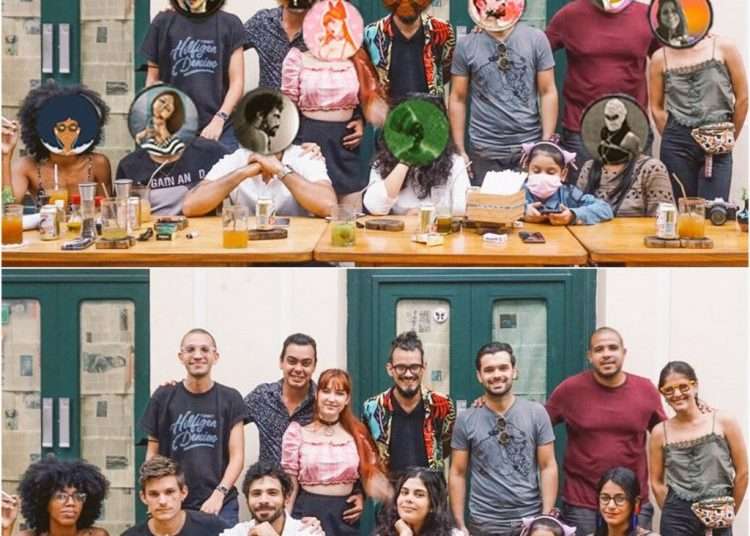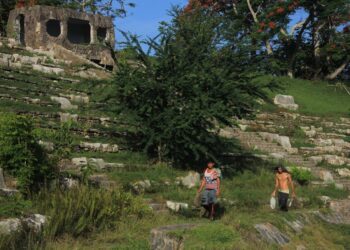As a good son of technology raised in the prosperous environment of the digital world, crypto art is growing at an accelerated pace in the midst of a reality where people interact more and more through the virtual space, with dynamics that are constantly modified and leave us without time to fully adapt to such a complex world.
Thus, cryptocurrencies and all the dynamics they imply play a fundamental role where there are not a few who presage that the future of the economy could turn towards these technologies, although the most skeptical still do not fully trust this incipient market due to its high speculation rates.
In this scenario, the Cuban artistic sector has managed to get the pulse of the digital market, inserting itself in the NFT market with enough solvency, considering the backwardness and the deficiencies in technology in the country.
Hence the emergence of ETH Cuba, a community created in Telegram with the aim of providing information beyond the artistic sector linked to crypto art, but focused on all those interested in knowing about the Ethereum (ETH) cryptocurrency and all the digital framework that accompanies it.
Kina Matahari, artist and curator, carries out this project with the help of other promoters and curators from Latin America, with the purpose of inserting the Cuban artistic community into the environment of Latin American crypto art, and also to provide knowledge to anyone who wishes to know more about the universe of blockchains and cryptoeconomies.
“The idea came up in a Twitter space about a month ago. The first one I did was called Informal Conversation about NFT and initially I started talking with a friend who wanted to ask me some questions about his project in NFT and other members of the Spanish-speaking community, mostly Latin American, joined in,” the young artist told OnCuba.
“That room grew until it reached about 80 participants and there I met Gustavo Solmott who is a gallery owner and manager of educational art projects and also about blockchains in Colombia, which will be the next venue of Devcon, the most important annual meeting of the community of developers within the blockchain, which this year will be focused on the Latin American community,” she added.
How would you describe ETH Cuba?
It is essentially an educational project to provide the community with tools about the operation of the blockchain, from basic information about its operation to how to develop your own smart contracts, tools that can help you once you are inserted in these ecosystems to make more viable the work.
In that first moment Solmott, as a result of the conversation we had in Cuba, proposed a type of educational community about the Ethereum approach and also offered me to get in touch with the Ethereum Foundation, to carry out this educational activity in which they are also interested.
This suggestion was more than timely because, even for me who am a creator of NFT, it has given me a space in cryptoeconomy from my role as creator and curator. I believe that otherwise I would not have become interested in cryptocurrencies and I have been able to get to know about many aspects in which I was not clear, and it is always very useful to have more knowledge about the area we are dealing with.
Currently, the members of the ETH Cuba team are Ernesto Cisneros, Christian Rodríguez and Gustavo Solmott, accompanied by Skylar Weaver, from the ETH Foundation.
Cryptocurrencies in Cuba: innovations and opportunities (II)
Why create this educational project?
If you find yourself moving in an ecosystem you will relate much better in it the more you know it. Most of us have arrived there almost intuitively because for Cubans it is complicated, especially because of the technological backwardness we have with respect to the Internet, with a great lag compared to the rest of the world. With this backwardness that we have, we must learn everything possible to avoid moving in a torpid or intuitive way, but more focused so that the strategies we develop work.
Hence the importance of this educational strategy in cryptoeconomies. I think it is not only important for the Cuban artistic community, but for the Cuban community in general. The group is not focused exclusively on artists, but on the Cuban community in all its breadth, although art has opened a door in this type of commercial transactions that NFTs represent, but anything in the world that is digital or material can be commercialized through these channels and the security provided by these firms in terms of the owner and the person who has acquired it, where everything is registered and assigned to the value of a cryptocurrency.
It is even speculated that this type of marketing technology is what dominates commercial transactions; although technology is constantly being renewed and although this is only the beginning or a pattern of a type of commerce that is later strengthened, it is setting an important guideline right now.
Advantages and disadvantages of this incipient market…
On the one hand, greater democratization for the opportunities of creators who want to market their work without going through other traditional framed filters of art — which are really quite strict — such as galleries and other types of markets, and in this case any creator, having a wallet can be inserted into a commercial system where you can always find a consumer who likes your art.
On the other hand, there is that democratization of commercial spaces and also the security of smart contracts with the signature of the blockchain that issues a kind of certificate of authenticity on the work, both of who has issued it as well as of the property of the person who purchases the product.
On the disadvantages, being a space with a high dose of speculation well, obviously, you can be inflating a bubble, building a castle that at some point falls, but in the world almost everything works by speculation, so while it is working it will be good to be a part of it, because it’s something that seems to show a change in the way things work not only in art, but in business relationships in general.
Also the obsolescence of the technology could be another disadvantage, since all these technologies are constantly being renewed, which may even be the end of that bubble. The moment a technology exceeds the one in use, an instability occurs that can endanger the systems in which crypto art is being generated right now.
Do you think that in the future a structure could be formed in this crypto market similar to the one existing in physical gallery spaces?
You have to understand that decentralization is not about eliminating the center, but about moving that center from place, and when you analyze the origin of the NFT boom, you find that it is part of a system that originates in the traditional art market. Christie’s and Sotheby’s, two of the most prestigious auction houses in the traditional art market, are the ones that started the marketing of NFTs, together with the Ethereum blockchain, which has been one of the most active in terms of sales of NFTs and those with the most successful marketplaces at the moment.
In some ways, it does reproduce patterns similar to what happens in traditional art spaces. There is also a standardization of prices; there are the artists who sell at 69 million, there are the artists who sell at 0.1 ETH and there are those who sell at 0.0003 ETH; there are artists who dedicate themselves to making 1×1 works that are unique works that can increase their value, as is the case in the traditional art market; as well as the aesthetics of videogames has its specific prices; 3D is valued more than illustration, which is also highly valued; there are also the collectibles.
Here what must be understood is that a traditional market is being imported from its physical environment to this one. These auction houses already existed — even online auctions — for a long time, which is now added to the NFT smart contract, a technology that enables the issuance of a certificate, such as a document with a series of codes that authenticates the work and gives it an added value and equivalent to that of a cryptocurrency.
The same as occurs in collecting. As this collector himself acquires a work because he likes it and wants it, because he has an emotional bond with it or simply for business, the interested party must have money to obtain this work.
In the case of crypto art, there is on the one hand the value of the dependence on this currency to which the work is linked in some way, and on the other, there is the value of the art itself. So the growth value of that digital asset you have in your hand is double because, on the one hand, it depends on the value and growth of the cryptocurrency itself, and on the other on the value of the artwork itself.
How do you assess the current moment of the artistic community of the NFT in Cuba? Would an insertion of traditional gallery spaces be helpful in this market?
I think the market structure that existed in physical space went digital because physical space was practically dead due to the pandemic. In this period, the NFT boom occurs because everything was closed due to COVID-19: galleries and museums. So the market needed to move and I think that everyone came out winning: that of traditional art that reactivates auctions and sales in a field where a lot of money moves and on the other hand cryptocurrency increased its value due to these dynamics and the incorporation of a whole artistic community.
I think we can say that the Cuban artistic NFT community is living a golden age and can get even better because it enjoys global prestige, both in the Anglo-Saxon and Latin segments. Many collectors are interested in the Cuban community and because we function in such an active way and working together, all of this is seen in the NFT interactions and ecosystems.
CryptoCuban Social Club, un coleccionable cubano “hecho a mano”
Thanks to the support of collectors and also outreach projects, we are working with high international standards, with very good artists in the Cuban community, some are even involved in the world of traditional art such as Lázaro Saavedra, Luis Gómez, Humberto Díaz, Marlon Portales, among the new generations, and there is the case of Bianchini with his CryptoCubans, a project at the height of others of the so-called “first world” and precisely he has been one of the main promoters among the Cuban community.
Among the models of projects or galleries that have been inserted is that of the Fábrica de Arte Cubano, also artists who have been working on collective projects, use the same account and from there develop their works.
The insertion of physical spaces of the traditional market is necessary and essential. Now is the moment and it may even be a bit late for these spaces, so if someone has identified you and wants to join, do so now and join the bandwagon, even more so if your project handles recognized artists. Commercialization has moved towards these spaces and right now a gallery that wants to enter a more active market dynamic must be inserted as soon as possible.
Musicians, self-taught artists, illustrators, designers are also inserted into the Cuban artistic community…our community is diverse and enjoys its best moment of prestige within the NFT universe.














